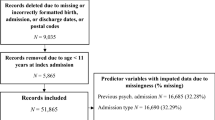Abstract
Since the rapid expansion of managed care coupled with dramatic reductions in lengths of inpatient stays, there is widespread concern that the emphasis on cost containment is eclipsing attention to patient care. The present study was undertaken to evaluate speculations that the majority of short-stay (less than 48 hours) admissions to a psychiatric inpatient service at a large teaching hospital in the midwestern United States consisted of public pay patients who were rapidly transferred to area state hospitals. Using two case mix measures, severity of illness and changes in acuity and clinical outcomes of a sample of short-stay (n = 77) and longer stay (n = 145) admissions were compared. Short-stay admissions, although similar to longer stay patients in terms of demographics, Axis I diagnosis, payer status, and appropriateness of admission, are clinically distinct. The use of nonhospital alternatives in treating a subsample of suicidal patients and the implications for improved mental health service delivery are discussed.
Similar content being viewed by others
References
VandenBos GR: U.S. mental health policy: Proactive evolution in the midst of health care reform.American Psychologist 1993; 48:283–290.
Johnston R, McNeal BF: Statistical verses clinical prediction: Length of neuropsychiatric hospital stay.Journal of Abnormal Psychology 1967; 72:335–340.
Lindemann JE, Fairweather GW, Stone GB, Smith RS: The use of demographic characteristics in predicting length of neuropsychiatric hospital stays.Journal of Consulting Psychology 1959; 23:85–89.
Manderscheid RW, Sonnenschein NA (Eds.):Mental Health, United States, 1990. DHHS Publication No. (ADM) 90-1708. Washington, DC: U.S. Govt. Printing Office, 1990.
Lyons JS, Colletta J, Devens M, et al.: The validity of the Severity of Psychiatric Illness on a sample of geropsychiatric inpatients.International Psychogeriatrics 1995; 7:407–416.
Lyons JS, O'Mahoney MT, Dworkin LN, et al.: The prediction of short-stay psychiatric inpatients.Administration and Policy in Mental Health 1995; 23:17–25.
Lyons JS, Finkel SL, Thompson BJ, et al.: Psychiatric partial hospitalization for older adults: Case mix and outcome.Continuum: Developments in Ambulatory Mental Health Care 1996; 3:1–5.
Lyons JS, Shasha M, Christopher NJ, et al.: Decision support in managed mental health care. In: Stout CL (Ed.):The Integration of Psychological Principles in Policy Development. New York: Greenwood, 1996, pp. 160–170.
Lyons JS, O'Mahoney MT, Miller SI, Neme J, Miller F: Predicting readmission to the psychiatric hospital in a managed care environment: Implications for quality indicators.American Journal of Psychiatry 1997; 154: 337–340.
Lyons JS, Stutesman J, Neme J, et al.: Predicting psychiatric emergency admissions.Medical Care 1997; 35:1–9.
Muijen M, Marks IM, Connoly J, et al.: The daily living programme: Preliminary comparison of community versus hospital-based treatment for the seriously mentally ill facing emergency admission.British Journal of Psychiatry 1992; 160:379–384.
Dincin J, Wasmer D, Witheredge TF, et al.: Impact of assertive community treatment on the use of state hospital inpatient bed days.Hospital and Community Psychiatry 1993; 44:833–838.
Ellison JM, Wharff EA: More than a gateway: The role of the emergency service in the community mental health network.Hospital and Community Psychiatry 1985; 36:180–185.
Schneider SE, Ross IM: Ultra-short hospitalization for severely mentally ill patients.Psychiatric Services 1996; 4:137–138.
Ianzito IM, Fine J, Sprague B, et al.: Overnight admission for psychiatric emergencies.Hospital and Community Psychiatry 1978; 11:728–730.
Breslow RE, Klinger BI, Erickson BJ: Crisis hospitalization on a psychiatric emergency service.General Hospital Psychiatry 1993; 15:307–315.
Gillig PM, Hillard JR, Bell J, et al.: The psychiatric emergency service holding area: Effect on utilization of inpatient resources.American Journal of Psychiatry 1989; 146:369–372.
Kasley GB, Ianzito BM: Development of an emergency psychiatric treatment unit.Hospital and Community Psychiatry 1984; 35:1220–1222.
Stroul BA: Residential crisis services: A review.Hospital and Community Psychiatry 1988; 39:1095–1098.
Bengelsdorf H, Alden DC: A mobile crisis unit in the psychiatric emergency room.Hospital and Community Psychiatry 1987; 38:662–665.
Author information
Authors and Affiliations
Corresponding author
Rights and permissions
About this article
Cite this article
Yohanna, D., Christopher, N.J., Lyons, J.S. et al. Characteristics of short-stay admissions to a psychiatric inpatient service. The Journal of Behavioral Health Services & Research 25, 337–345 (1998). https://doi.org/10.1007/BF02287472
Issue Date:
DOI: https://doi.org/10.1007/BF02287472




